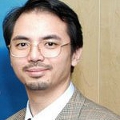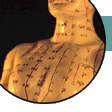|
 |
Introduction to TCM

Basics of TCM

• Yin-Yang | Five Elements

Zang-Fu Theories

• Zang Organs | Fu Organs

Classification of Antineoplastic Herbal Medicines

Characteristics of Herbal Medicines

Diagnose

• By Auscultation & Olfaction
• By Inspection

Prescriptions

Theories of Channels (Meridians) and Collaterals

Reference: A Modern View of the Immune System

Differentiation of Syndromes

• 8 Principles
• 6 Channels 4 Stages
• Syndromes of Zang-Fu Organs

Etiology

• Exogenous
| Pestilential
• Pathogenic Factors
• Emotional

Materia Medica


Back to Home

|
 |

Application of the Five Elements Theory to Traditional Chinese Medicine
The Five Elements theory is applied to the physiology and
pathology of the human body by using the relationships of generation
and subjugation to guide clinical diagnosis and treatment.
The Physiological Functions and Interrelationships of the Five Zang Organs
Physiologically the Five Elements theory explains the unity of the mutual
relationships between the zang-fu organs and body tissues as well as
between the human body and nature. The physiological activities of the
five zang organs can be classified according to the different
characteristics of the five elements. For example, the liver is said
to preside over the vigorous flow of qi and also has the function of
ensuring free qi circulation. Since these characteristics are
similar to the properties of wood, the liver is categorized as wood in
the scheme of the five elements. Heart yang has a warming action so it
belongs to the category of the fire element. The spleen is the source
of transformation of essential substances and is associated with the
earth element's characteristics of growth and transformation. The
lung has clearing and descending properties and is associated with
the metal element's characteristics of clearing and astringency. The
kidney has the function of controlling water metabolism and storing
essence and is associated with the water element's characteristics
of moistening and flowing downward.
The Five Elements theory is also used to describe the correlations
of physiological functions between zang-fu organs and body tissues.
There are both generating and subjugating relationships among the five
zang organs. The generating relationships are: the essence of kidney
(represented by the water element) nourishes the liver; the liver
(represented by the wood element) stores the blood in order to support
the heart; the heat of the heart (represented by the fire element) warms
the spleen; the spleen (represented by the earth element) transforms
and transports the essential nutrients to replenish the lung; and the
clearing and descending functions of the lung (represented by the metal
element) assist the flowing of kidney water.
The subjugating relationships among the same organs are as follows:
the clearing and descending functions of the lung (metal element) can
restrict the hyperactivity of liver yang; the unobstructed flowing of liver
(wood element) qi is capable of removing the stagnation of the
spleen (earth element); the transportation and transformation of spleen
is able to subdue the overflowing of kidney water; and the nourishing
and moistening function of kidney (water element) can prevent the
strong flaring up of heart fire. The yang heat of the heart (fire
element) can control the hyperactivity of the lung's clearing and
descending functions.
Furthermore, the Five Elements theory is employed to express the
mutual relationships between the human body with the seasons,
climates, and flavors. For example, while the wood element is associated
with East, spring, wind, sour, etc., it is also connected with the liver,
tendons, and eyes of the human body. In this way the Five Elements
theory gives expression to a holistic view of the relationship between the
human body and its natural environment.
Five Elements Theory and Pathological Influences on the Zang-Fu Organs
Five Elements theory is not only used to correlate the functions
of the sang-fu organs, but also to demonstrate their mutual
pathological influence. To denote the mutual influence of the
sang-fu organs in pathological changes the concepts of extreme
subjugation and counter subjugation are used. For example, liver
disease may affect the spleen because wood over-subjugates earth,
while spleen illness may affect the liver as earth counter subjugates
wood. Diseases of the liver and spleen interact with each other. Liver
disease may also influence the heart, this is a "mother affecting son"
illness. If the liver disease is transmitted to the lung, this
is categorized as wood counter subjugating metal. If it is transmitted
to the kidney, then it is considered a "son affecting mother" illness.
The other zang organs follow suit. Thus the application of the Five
Elements theory in explaining the complicated interaction between the
zang organs can be summed up by these four relationships: extreme
subjugation, counter subjugation, mother affecting son illness, and
son affecting mother illness.
Use of the Five Elements Theory in the Diagnosis and Treatment of Disease
Abnormal changes of the internal organ's functions and interrelationships
can be detected by external appearances. Thus changes in a a patient's
complexion, voice, sense of taste, pulse, etc. can be used to diagnose
disease. According to the Five Elements theory the five zang organs
have certain connections with the "five colors," "five tones," and
"five tastes" as well as changes in the pulse. Therefore, in the
clinical diagnosis of a disease, the data collected by the four
diagnostic methods (inspection, auscultation and olfaction, inquiring,
and palpation) should be analyzed according to the properties and
changing laws of mutual generation and subjugation, extreme subjugation,
and counter subjugation of the Five Elements theory. For example, a
blue complexion accompanied with a preference for food of a sour taste
and a wiry pulse, suggests liver disease. A flushed face accompanied by
a bitter taste in the mouth and a forceful pulse suggests heart disease
with the symptom-complex of hear-fire flaring up. A patient with
insufficient spleen qi may have a blue complexion implying wood's (i.e.
liver) extreme subjugation of earth (i.e. spleen). If a patient is
suffering from heart trouble and has a dark complexion, it may be
explained as water (i.e. kidney) subjugating fire.
The occurrence and development of a disease is sometimes related to
the abnormality of the mutual generation and subjugation relationships.
Therefore, clinical treatment should not only concentrate on the diseased
zang organ, but also be concerned with readjusting the relationships
between the particular zang or fu organs in accordance with Five Elements
theory. For example, the Nanjing says, "When the liver is diseased,
the liver will transmit to the spleen, and so one should replenish the qi
of the spleen." This reflects the clinical application of five element's
extreme subjugation theory. The laws of mutual generation and
subjugation and extreme subjugation and counter subjugation
have been applied by subsequent generations of traditional Chinese
medicine practitioners to create more methods of treatment such
as "cultivating the earth in order to generate metal," "nourishing
the water to conserve wood," "supporting the earth to restrict wood," etc.
The yin-yang and Five Elements theories represent the
world outlook and methodology of the ancient Chinese for their
understanding and explanation of nature. The application
of these two theories to Chinese medicine consists of viewing
the phenomena and laws of nature and applying them to the study
of the physiological activities and pathological changes of the
human body and its interrelationships. The theory of Yin-Yang
explains the dynamics of physical objects through a consideration
of their contrary, mutual depending, consuming-increasing and
transforming relationships. Normal human physiological activities are
understood as the relative balance and harmonization between yin
and yang. When yin and yang lose their relative balance and
coordination, disease occurs. The theories of Yin-Yang and the
Five Elements are used together as a guide to clinical diagnosis
and treatment.
|

|
|
|
|
|
 |

|
WHAT IS TRADITIONAL CHINESE MEDICINE?

Photo © Image DJ Image Dictionary
With over 3000 years of experience, Traditional Chinese Medicine (TCM) has
remain one of the many fascinating areas in ancient Chinese culture.
First known to be documented in the Yellow Emperor's Canon of Medicine,
TCM is believed to have been practised in as early as 475 to 221 B.C.
The field of working knowledge of TCM stretches from anything related to
general healthcare practice to the philosophy of the mind, the logic of life,
religion, and even to as far as cosmology and astronumerology. This is why
in order to thoroughly understand the concepts behind TCM, one must be
comprehensive in learning and embracing the Chinese culture as a whole.
Just as Douglas Hoff put it when he explained about accupuncture, "The systems
of TCM uses the concepts of elements and meridians and are completely immersed
in the Asian cosmology which takes shape through the religions." The meridian-brain mechanism,
the fundamental working concept of acupuncture, in which the pain block from the message
that the needle or burning cone of herbs gives to the point of stimulus,
was only found centuries later by the West through science and technology.
|
| |
|
MESSAGE FROM THE EDITOR – MARCH 2020
 Thank you for visiting this TCM and acupuncture information website.
If you have previously been to this website, you might have
noticed that some of the pages on ancient historical ideas and
holistic thinkings related to Chinese metaphysics are temporarily taken offline.
This is because I will be revamping the whole website and be moving
those information into a new \"Ancient Chinese Culture\" section
so as to reflect a more current perspective on the interpretation
of some of the fundamental concepts as well as to include
some of the latest information in the area.
But if you have just found this website for the very first time, I welcome you again and
wish you could find what you require and, hopefully, you could also be benefitted
from reading the articles I published on this website.
Thank you for visiting this TCM and acupuncture information website.
If you have previously been to this website, you might have
noticed that some of the pages on ancient historical ideas and
holistic thinkings related to Chinese metaphysics are temporarily taken offline.
This is because I will be revamping the whole website and be moving
those information into a new \"Ancient Chinese Culture\" section
so as to reflect a more current perspective on the interpretation
of some of the fundamental concepts as well as to include
some of the latest information in the area.
But if you have just found this website for the very first time, I welcome you again and
wish you could find what you require and, hopefully, you could also be benefitted
from reading the articles I published on this website.
Please be patient and do come and check out this website frequently as it's being revamped.
Raymond Cheng, PhD DPA FRSA FRSPH

March 28, 2020.
|

|
IMPORTANT NOTICE AND DISCLAIMER

 This website is published, edited and designed by Raymond Cheng,
and reflects only and only his personal views and opinions in his individual capacity.
The information available at this website is not intended
directly or by implication to either diagnose or treat any
medical, emotional, or psychological condition or disorder.
It is also not intended to create a physician-patient relationship
between you and I or between you and Wyith Institute™ and The Office of Dr Raymond K K Cheng.
The information here is not a substitute for advice and treatment provided
by your physician or by another healthcare professional.
It is always recommended that consultation with local healthcare providers
be obtained for any of your specific health or medical concerns.
Furthermore, any products that can be purchased (yet you can see I don't have much
to sell here) through advertisers' banners or through links to other websites
are not either explicitly or implicitly given any warranty or endorsement
by me, my colleagues, Wyith Institute™ or any of its associated businesses.
This website is published, edited and designed by Raymond Cheng,
and reflects only and only his personal views and opinions in his individual capacity.
The information available at this website is not intended
directly or by implication to either diagnose or treat any
medical, emotional, or psychological condition or disorder.
It is also not intended to create a physician-patient relationship
between you and I or between you and Wyith Institute™ and The Office of Dr Raymond K K Cheng.
The information here is not a substitute for advice and treatment provided
by your physician or by another healthcare professional.
It is always recommended that consultation with local healthcare providers
be obtained for any of your specific health or medical concerns.
Furthermore, any products that can be purchased (yet you can see I don't have much
to sell here) through advertisers' banners or through links to other websites
are not either explicitly or implicitly given any warranty or endorsement
by me, my colleagues, Wyith Institute™ or any of its associated businesses.
|

|
|

 This website is published, edited and designed by Raymond Cheng,
and reflects only and only his personal views and opinions in his individual capacity.
The information available at this website is not intended
directly or by implication to either diagnose or treat any
medical, emotional, or psychological condition or disorder.
It is also not intended to create a physician-patient relationship
between you and I or between you and Wyith Institute™ and The Office of Dr Raymond K K Cheng.
The information here is not a substitute for advice and treatment provided
by your physician or by another healthcare professional.
It is always recommended that consultation with local healthcare providers
be obtained for any of your specific health or medical concerns.
Furthermore, any products that can be purchased (yet you can see I don't have much
to sell here) through advertisers' banners or through links to other websites
are not either explicitly or implicitly given any warranty or endorsement
by me, my colleagues, Wyith Institute™ or any of its associated businesses.
This website is published, edited and designed by Raymond Cheng,
and reflects only and only his personal views and opinions in his individual capacity.
The information available at this website is not intended
directly or by implication to either diagnose or treat any
medical, emotional, or psychological condition or disorder.
It is also not intended to create a physician-patient relationship
between you and I or between you and Wyith Institute™ and The Office of Dr Raymond K K Cheng.
The information here is not a substitute for advice and treatment provided
by your physician or by another healthcare professional.
It is always recommended that consultation with local healthcare providers
be obtained for any of your specific health or medical concerns.
Furthermore, any products that can be purchased (yet you can see I don't have much
to sell here) through advertisers' banners or through links to other websites
are not either explicitly or implicitly given any warranty or endorsement
by me, my colleagues, Wyith Institute™ or any of its associated businesses.



 Thank you for visiting this TCM and acupuncture information website.
If you have previously been to this website, you might have
noticed that some of the pages on ancient historical ideas and
holistic thinkings related to Chinese metaphysics are temporarily taken offline.
This is because I will be revamping the whole website and be moving
those information into a new \"Ancient Chinese Culture\" section
so as to reflect a more current perspective on the interpretation
of some of the fundamental concepts as well as to include
some of the latest information in the area.
But if you have just found this website for the very first time, I welcome you again and
wish you could find what you require and, hopefully, you could also be benefitted
from reading the articles I published on this website.
Thank you for visiting this TCM and acupuncture information website.
If you have previously been to this website, you might have
noticed that some of the pages on ancient historical ideas and
holistic thinkings related to Chinese metaphysics are temporarily taken offline.
This is because I will be revamping the whole website and be moving
those information into a new \"Ancient Chinese Culture\" section
so as to reflect a more current perspective on the interpretation
of some of the fundamental concepts as well as to include
some of the latest information in the area.
But if you have just found this website for the very first time, I welcome you again and
wish you could find what you require and, hopefully, you could also be benefitted
from reading the articles I published on this website.